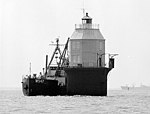Corcoran Woods
Annapolis, MarylandAnnapolis, Maryland stubsAnne Arundel County, Maryland geography stubsForests of MarylandLandforms of Anne Arundel County, Maryland ... and 3 more
Maryland protected area stubsNature reserves in MarylandProtected areas of Anne Arundel County, Maryland
Corcoran Woods, also known as Corcoran Environmental Study Area, or the Corcoran Tract, is a woodland preserve located in the northwest section of Sandy Point State Park in Annapolis, Maryland. The area comprises roughly 210 acres (0.85 km2) and is owned by the State of Maryland. Edward S. Corcoran previously owned the 110-acre (0.45 km2) northwest portion of Corcoran Woods.
Excerpt from the Wikipedia article Corcoran Woods (License: CC BY-SA 3.0, Authors).Corcoran Woods
Willow Lane,
Geographical coordinates (GPS) Address External links Nearby Places Show on map
Geographical coordinates (GPS)
| Latitude | Longitude |
|---|---|
| N 39.034166666667 ° | E -76.418055555556 ° |
Address
Corcoran Environmental Study Area
Willow Lane
21409
Maryland, United States
Open on Google Maps








